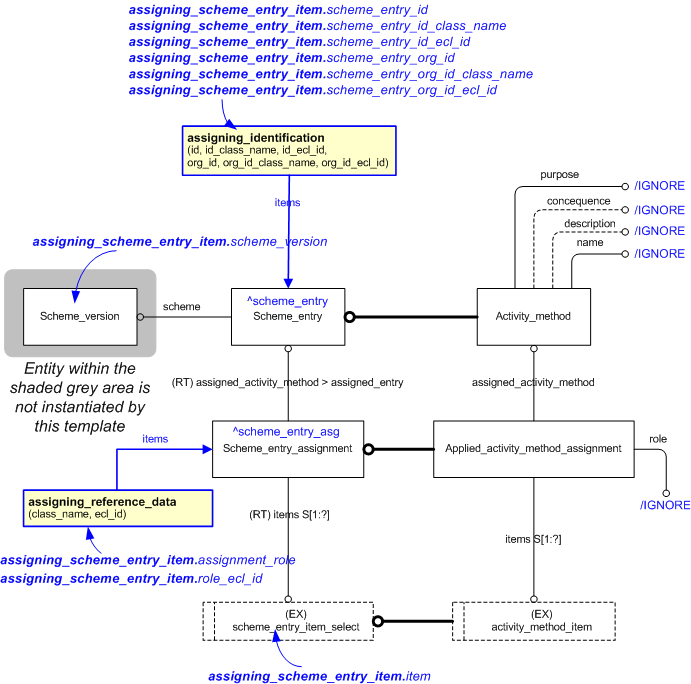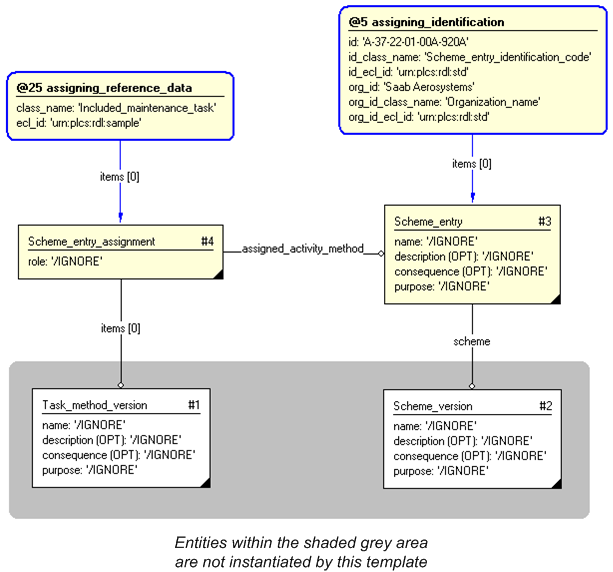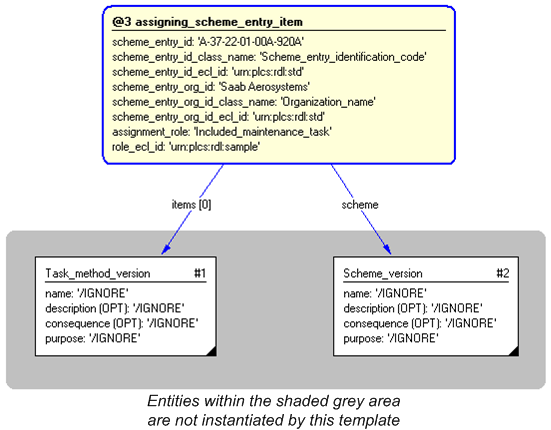Template:— assigning_scheme_entry_item (asg_scm_entry_item)
Context:— NOLITO |
Date: 2008/06/05 13:32:46
Revision: 1.1
|
This section specifies the template assigning_scheme_entry_item.
NOTE
The template has been defined in the context of
NOLITO.
Refer to the business context for details of related templates.
NOTE
An explanation of a template and the associated instantiation path is
provided in the
Template overview
section.
The EXPRESS-G diagram in
Figure
1
shows the templates and EXPRESS entities that are required
to represent the template
"assigning_scheme_entry_item".
The text highlighted in blue shows the template parameters.
Figure 1 — An EXPRESS-G representation of the Information model for assigning_scheme_entry_item
The graphic for the template to be used in other EXPRESS-G diagrams
is shown in Figure
2
below.
Figure 2 — The graphical representation of the assigning_scheme_entry_item template
The following input parameters are defined for this template:
The name of the
External_class that determines the type of identifier given by the
input parameter @scheme_entry_id.
The following classes and their sub-classes can be used:
classifications: [Scheme_entry_identification_code]![[warning:]](../../../../../../images/dex/warning.gif) Error RDL1: The class Scheme_entry_identification_code does not exist in RDL at urn urn:plcs:rdl:std. Check the dexlib/data/refdata/rdl_index.xml
Error RDL1: The class Scheme_entry_identification_code does not exist in RDL at urn urn:plcs:rdl:std. Check the dexlib/data/refdata/rdl_index.xml
The name of the
External_class that determines
the type of organization identification (@scheme_entry_org_id) being used. For example CAGE code.
The following classes and their sub-classes can be used:
The role of the assignment.
The following classes and their sub-classes can be used:
The target element of the assignment.
The following reference parameters are defined for this template:
Allow the
Scheme_entry
entity instantiated in this path to be referenced when this template is used.
Note: The
Scheme_entry
entity can be referenced in a template path by:
%^target = $assigning_scheme_entry_item.scheme_entry%
where
target
is the parameter to which the
Scheme_entry
is bound.
%^target = $assigning_scheme_entry_item.scheme_entry_asg%
The instantiation path shown below specifies the entities that are to be
instantiated by the template.
A description of templates and the syntax for the instantiation path is
provided in the
Templates Help/Information section.
The following entities are instantiated with attributes as specified:
The instance diagram in Figure
3
shows an example of the EXPRESS entities and templates that are instantiated by the template:
/assigning_scheme_entry_item(scheme_entry_id='A-37-22-01-00A-920A', scheme_entry_id_class_name='Scheme_entry_identification_code', scheme_entry_id_ecl_id='urn:plcs:rdl:std', scheme_entry_org_id='Saab Aerosystems', scheme_entry_org_id_class_name='Organization_name', scheme_entry_org_id_ecl_id='urn:plcs:rdl:std', assignment_role='Included_maintenance_task', role_ecl_id='urn:plcs:rdl:sample', item='#1', scheme_version='#2')/
(an illustration of the consolidated assigning_scheme_entry_item template is shown in
Figure
4 below.)
Figure 3 — Entities instantiated by assigning_scheme_entry_item template
The instance diagram in
Figure
4
shows the graphic symbol for the template that is to be
used in other instance diagrams. The example template is:
/assigning_scheme_entry_item(scheme_entry_id='A-37-22-01-00A-920A', scheme_entry_id_class_name='Scheme_entry_identification_code', scheme_entry_id_ecl_id='urn:plcs:rdl:std', scheme_entry_org_id='Saab Aerosystems', scheme_entry_org_id_class_name='Organization_name', scheme_entry_org_id_ecl_id='urn:plcs:rdl:std', assignment_role='Included_maintenance_task', role_ecl_id='urn:plcs:rdl:sample', item='#1', scheme_version='#2')/
Figure 4 — Instantiation of assigning_scheme_entry_item template
Characterizations
No common characterizations of the template
assigning_scheme_entry_item
have been identified. However, the ISO 10303-239 EXPRESS model
may enable other assignments to the entities instantiated by the template.




